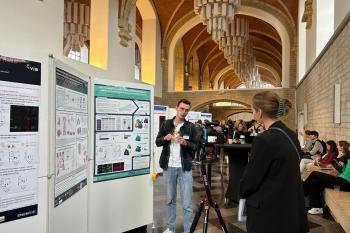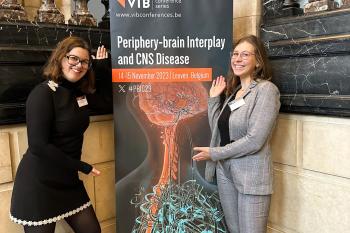Gathering 200 scientific minds, the Periphery-Brain Interplay and CNS Disease conference illuminated the intricate connections between the peripheral systems and the brain. This event, hosted at the forefront of scientific research, provided a comprehensive overview of the latest advancements, challenges, and promising avenues in understanding central nervous system (CNS) diseases through the lens of the interplay between the peripheral and central mechanisms.
The program offered 18 invited speakers and 7 abstract-selected speakers a platform to showcase the exciting work being done in this field. The lineup featured scientists from diverse genders, ages, backgrounds, and scientific fields, making it a true melting pot of expertise.
We asked Beth Stevens (Boston Children’s Hospital; Broad Institute, US) and Roosmarijn Vandenbroucke (VIB-UGent Center for Inflammation Research, BE), both OC member and speaker, why this topic is so relevant now:
Beth: We chose this topic because over the past few years, in particular, there is just been an emergence of exciting new data, that suggesting that it’s not all happening within the brain in terms of neuroimmune interactions. But in fact, it really involves crosstalk between the periphery and the brain in many different contexts both in health and disease. This meeting brings together all of that into one meeting to discuss new and unpublished data on this topic.
Roosmarijn: For years it was believed that our brain was really isolated from the rest of our body, but in the last 10 years or so people realized that there was a lot of communication between the periphery and the brain. And especially during diseases, this seems to play a really important role. So it was really a timely topic to gather some experts in the field, who are focusing on the interplay between the periphery and the brain.
At the end of this news article, you can find the full video interviews with Beth and Roosmarijn. Check the PBIC23 Google photo album to find some impressions of the meeting.
Interviews with poster presenters
The PBIC23 conference featured 2 poster sessions where 78 poster presenters had the chance to showcase their research. We interviewed a few of them, and you can find their short poster pitches here:
Insights and Impressions: VIB Conference Reporters Reflect on PBIC23’s Scientific Highlights
During the conference, India Jane Wise(VIB Science Communications Expert, BE) and Baukje Bijnens(PhD Student at VIB Center for Molecular Neurology, BE), our two VIB conference reporters, covered the conference proceedings on social media. Here are their impressions of the PBIC23 conference here:
India: Menna Clathworthy kicked things off, paving the way for intriguing discussions on the gut-brain axis. Colm Cunningham’s deep dive into body-brain signaling and its impact on homeostasis was a real eye-opener, and Julie Siegenthaler provided a great perspective with her take on immune surveillance at the brain’s borders. But it wasn’t just the main acts stealing the show.
The selected talks offered new angles and showcased the broad range of scientific discoveries in the field.Between sessions, it was great to see the palpable enthusiasm among the researchers to engage with each other, get new ideas, and even form potential collaborations. The poster presentations created an environment where all participants mingled, which also added to some animated discussions. It seems like everyone would be delighted to see the event return for a second edition in the future!
Baukje: I had a lovely two days talking to very talented scientists at PBIC23! I was amazed by how much you can see that the field of neuro-immunology succeeds at bringing biology, technology, and bio-informatics together, to aid our general understanding of biology. Thanks to John Cryan, I know why the “gut feeling” matters, and why we need technology to leverage cell-cell interaction from Francisco Quintana. While these were merely examples, the lineup of speakers was all-around excellent.
The whole conference had me quite stunned at the complexity of the interplay between both the periphery and the brain, and even individual cells. All together this was a delightful conference, with a beautiful venue, excellent organization, and a great set of speakers. I am already looking forward to the next edition!
The value of conference attendance
Because of their extensive experience, we asked Beth Stevens and Roosmarijn Vandenbroucke why they think it’s essential for scientists to attend conferences:
Beth: Attending conferences is critical, not just for scientific exchange of ideas but I think for networking, for collaborations, for fostering new ideas. I mean, a lot of the things that stem from even informal discussions during coffee hours, have really sparked new collaborative projects, at least in my lab.
I think it is also super important for our trainees to have an opportunity to meet the people in the field that they have been reading about and reading their papers but have never met in person. This can lead to new post-doc and new training opportunities. It’s been fantastic, and I think coming together in person, especially after the pandemic, it’s just been really important. We missed that, and I think this meeting is particularly good timing.
Roosmarijn: You have personal contact with people you haven’t met before. So it has a huge impact on really getting to know more people in the field you are working on. It’s really important I think, in the career of a researcher to be able to do this.
The vibrant city of Leuven provided a fitting backdrop for this intellectually stimulating gathering, offering a conducive environment for networking and exchange of ideas among attendees.
As the conference drew to a close, participants departed with a renewed sense of purpose and commitment to advancing our understanding of CNS diseases through exploring the intricate connections between the periphery and the brain. Jennifer Morael also departed with the Neuron Poster Prize, which she won for her poster presentation where she suggested that maternal gut microbiota modulates blood-cerebrospinal fluid barrier function (permeability and immune status) in the offspring, which is inherently linked with proper brain homeostasis and neurodevelopment.
The event concluded on an optimistic note, setting the stage for continued collaboration and innovation in this burgeoning field.

